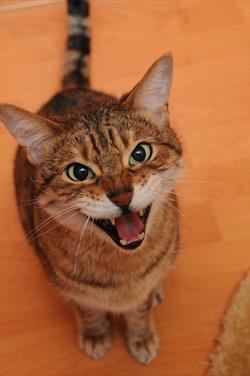A reader once asked me, “My cat is an avid hunter, and in our area there appears to be a plentiful supply of rats and mice. He was bringing me samples on a daily basis and I had to export the live ones and bury the dead ones. I now partially closed the cat door so that he could get out but not in. However, this leaves him out at night and there seems to be creatures out there that could hunt him. Do you have any suggestions for what I should do? Can I program him to leave his presents outdoors? “
Hunting is a Strong Instinct for Many Cats
Unfortunately, this is a tough problem to solve through training. Cat’s who never have the opportunity to hunt early on often never develop a taste for the sport. Many are even fearful of rats and large mice. Once a kitty develops a taste for the hunt though, there’s no turning back. Rats, mice, lizards, birds beware. Kitty will hunt them like his life depends on it and cats, being such avid hunters, can have a major impact on the local songbird and small mammal population. They’ll tenaciously seek their sport and bring a sampling of their catches back, dead or alive to the place they consider home.
Even a full stomach won’t stop his game. While hunger can increase predatory drive, most housecats hunt for thrill, not just for food. In fact, cat researchers have known for many years that hunger and hunting are under separate control in the brain. Cats engrossed in a tasty meal will break away from their flavorful feast to hunt rats that just happen by (i.e. those conveniently placed in the same room by a researcher studying predatory behavior in cats). They’ll seek and destroy and drag their unfortunate catch back. Then, they’ll resume eating their regular meal leaving the rat, perhaps for another day.
Why Surplus Killing is Common
This hunting for sport and playing with prey may seem cruel, but in the animal world, surplus killing is not that unusual. Just ask the farmer whose chicken coop has just been raided by the local fox or raccoon. It seems a perplexing practice at first until you consider that in the wild, hunting is a big business. While a well-fed house cat may spend up to a quarter of each day hunting, feral cats who survive on their catch can spend over half of their day hunting. They carefully spy, stalk, pounce, and bat, and for all their stealth, they’re only successful one out of ten times.
With that poor track record, cats as well as other predators needs a strong drive to hunt, otherwise a few misses and Kitty would give up and starve. For these avid sportsters, when the picking’s easy they can’t help but rack up the points.
What are Your Options?
So where does all this leave you? Given that your cat’s addicted to the hunt and that’s not going to change, you do have options, although none are ideal. Option one is to keep Kitty outside permanently. Then Kitty can hunt all day yet will never bring his presents in the house for your pleasure or his play. The problem here is that a permanently unsupervised kitty is an unsafe kitty. All that time tracking the call of the Wild can quickly turn Kitty from predator to prey. Furthermore, cats in general tend to hide signs of illness until they’re very sick. If you only see Kitty briefly each day, early symptoms are sure to be missed.
One compromise is to keep the wily hunter out all day and bring him in at night. A small morning meal and a larger tastier meal at night will help ensure that he comes home on cue. This still won’t prevent possible mass destruction of small furry things that might serve as food for owls, hawks and other wildlife. Even wearing a kitty-safe collar with a bell won’t cut down on captures since the bells have no meaning to birds and rodents. Plus, neither a bell, nor coming in at night will remove her chances of being hit by a car or eaten by day predators.
A better option both for the local prey population and for Kitty’s overall safety is to keep Kitty inside permanently. This is sure to keep him from hunting mice and birds but not necessarily from attacking shoes and legs or from yowling to be let out. To keep him from diverting his predatory prowess to your precious pants and retrain him to enjoy indoor life, you’ll have to provide some replacement toys and fill his extra time with interactive play. I recently had to revoke my cat, Dante’s, outdoor privileges since our outdoor cat containment system wasn’t containing him. By rewarding him for performing tricks and for sitting with portions of his meal within a couple of days he stopped yowling and laying in wait to dart out the door. Now he seems content to be inside-only again.
In addition to this indoor option, you can add an outdoor enclosure or containment system. Hopefully yours will work better than mine, which has been up for 10 years and needs replacing. In fact, for those readers who have a system they like, please send photos!
Oh yeah, and how about a fourth option — training Kitty to leave his presents outside? With clever planning and tenacious execution, maybe a master at cat training could get the job done……eventually. The rest of us would just get old trying.
Revised from article originally in the SF chronicle




